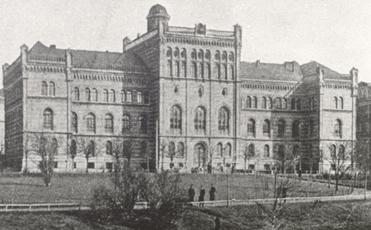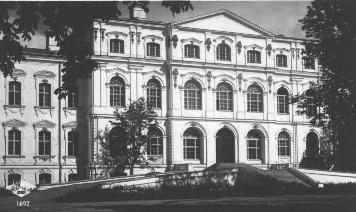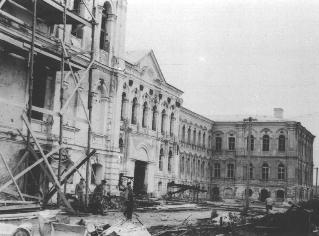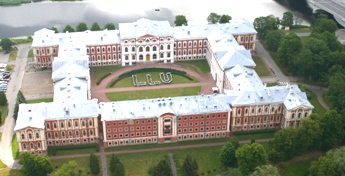PALACE AND UNIVERSITY
1862 - 1923

The origins of higher agricultural education

The main building of the University of Latvia at the
end of the 19th century.
- In 1862 the Riga Polytechnic Institute was founded - the first students were admitted to the Preparatory Grade.
- In 1863, in the Riga Polytechnic School the Department of Agriculture was founded, in which it was possible to obtain higher education in agriculture.
- In 1896, the Riga Polytechnic Scool was transformed into the Riga Polytechnic Institute. The Department of Agriculture was located in the laboratory building of the Institute on Pushkin Street (now A. Kronvalda Boulevard, 4).
- On September 28, 1919, the grand opening of the Latvian Higher School took place. The Agricultural Faculty consisted of two departments - Agriculture and Forestry. At the same time, the Faculty of Veterinary Medicine opens its doors for students for the first time.
- In 1920, the Department of Forestry was created in the Faculty of Agriculture, and in 1921 the center of the Vecauce estate with the lands belonging to it was transferred to the faculty.
- In 1923, the Latvian Higher School was renamed as the University of Latvia.
1936 - 1941

Creation of an independent institution of higher education

Jelgava Palace in 1939
- On July 26, 1936, the Cabinet of Ministers made a decision to transfer the Faculty of Agriculture of the University of Latvia to Jelgava, thus creating a new institution of higher education - Jelgava Academy of Agriculture.
- On December 23, 1938, Prime Minister Karlis Ulmanis signed the Law on “Statute of the Jelgava Academy of Agriculture”.
- On July 3, 1939, the Jelgava Academy of Agriculture was opened, in which there were two faculties: Agriculture and Forestry.
- On October 28, 1939, the premises of the Jelgava Academy of Agriculture were consecrated with the participation of the President Karlis Ulmanis.
- In 1940, the curriculum of the Academy was changed in accordance with the models of the universities of the USSR. The term of study at both faculties of the Jelgava Academy of Agriculture was extended to five years.
- On June 29, 1941 Jelgava was occupied by the German fascist army, and the Jelgava Academy of Agriculture was renamed as the Academy of Agriculture in Mitava.
1944 - 1961

Restoration of the Academy

Restoration works in the Jelgava Palace in 1961.
- In July 1944, the Jelgava Palace was ruined and the University ceased to exist. It was reopened in Riga as the Latvian Academy of Agriculture with five faculties - the Faculties of Agriculture and Forestry, the Faculty of Veterinary Medicine - transferred from the University of Latvia, as well as the newly created Faculties of Agricultural Mechanization and the Faculty of Agrotechnics and Households.
- In 1945 at the Latvian Academy of Agriculture was established the Department of part-time studies.
- In 1947, the Faculty of Land Management was established at the Latvian Academy of Agriculture.
- In 1948, the Faculty of Hydromelioration was established at the Latvian Academy of Agriculture.
- In 1948, instead of the Faculty of Agrotechnics and Household, the Faculty of Food Industry Technologies was created.
- In 1949, the Forestry Engineering Faculty was created, and the Faculty of Agriculture was divided into two faculties - Agronomy and Zoo-technics.
- In 1955, the Department of part-time studies was transformed into the Faculty of part-time studies with five departments. During the 1955/56 academic year 972 students studied part-time
- In 1956, by a separate decision on October 20, the Bureau of the Central Committee of the Communist Party of Latvia allowed the Academy to publish its newspaper “Plēsums” - in Latvian, on four pages, in a format equal to half of the newspaper “Pravda”, with the frequency of 2 times per month, with a circulation of 1,500 copies. On November 3, the first issue of the newspaper “Plēsums” was published.
- On October 29, 1956, the Council of Ministers of the Latvian Soviet Socialist Republic made a decision to move the Latvian Academy of Agriculture to Jelgava.
- On September 1, 1957, the Faculties of Forestry and Timber processing, as well as the Faculties of Hydromelioration and Land Management, began to work in Jelgava. The transfer of other faculties from Riga to Jelgava continued until 1964.
- In 1960, male and female choirs, a combined song and dance ensemble, a stage ensemble, dance and drama groups acted at the Latvian Academy of Agriculture.
- In 1961, five problem laboratories and two scientific and industrial laboratories were established at the Academy of Agriculture in Jelgava.
1968 - 2018

New faculties are being created

The central building of the LLU - Jelgava Palace from
a bird's eye view in 2008
- In 1968, the Faculty of Agricultural Economics was established at the Latvian Academy of Agriculture.
- In 1984, the Faculty of Agricultural Construction was established at the Latvian Academy of Agriculture.
- In 1990, the Institute of Humanities opens its doors at the Latvian Academy of Agriculture.
- In 1990, the Institute of Informatics was established at the Latvian University of Agriculture.
- In 1993, by merging the faculties of Water Management, Land Management and Rural Construction, the Faculty of Rural Engineering was created. At the same time, the Faculty of Agriculture was created by combining the faculties of Agronomy and Zoo-technics.
- On February 5, 1998, the Saeima approved the Statutes of the Latvian Agricultural University, and on February 18, the President of Latvia Guntis Ulmanis announced its entry into force.
- In 2009, the illumination of the eastern facade of the Jelgava Palace, faced towards the Lielupe River, began to work.
- In 2011, the renovation of the third floor of the eastern wing of the Jelgava Palace was completed.
- Since September 1, 2012, the tradition of paving the academic road begins replacing the habitual tradition of the first grade students to plant trees in the park of the Jelgava Palace.
- In 2013, the Faculty of Economics and Social Development was established.
- In 2014, the reconstruction of the Valdeka Palace was completed.
- In 2015, the Senate Hall of the LLU was restored.
- In 2016, the contract was signed on the implementation of the project “Improving Energy Efficiency and Renovation of the Facade of the Jelgava Palace”.
- In 2017, the replacement of the windows and doors of the southern wing of the castle and insulation of the attic was started. Also, the repairment of the building facade and ventilation systems was started. As well as cosmetic repair in the Southern Colonnade.Type a message
- On March 6, 2018, the Senate of the Latvian University of Agriculture approved the name of the university in English - "Latvia University of Life Sciences and Technologies".
- June 14, 2018 marks the 280th anniversary of the laying of the first stone in the foundation of the Palace. Reconstruction works have been completed in the central hall of the LLU, its foyer, as well as in the Gold and Silver halls.

